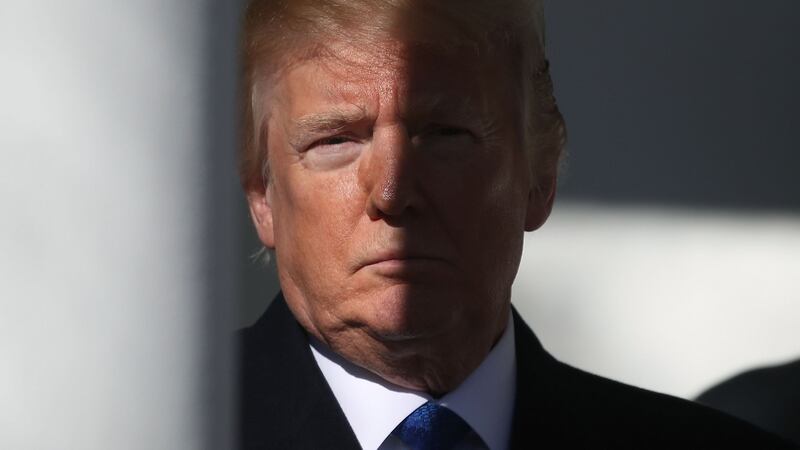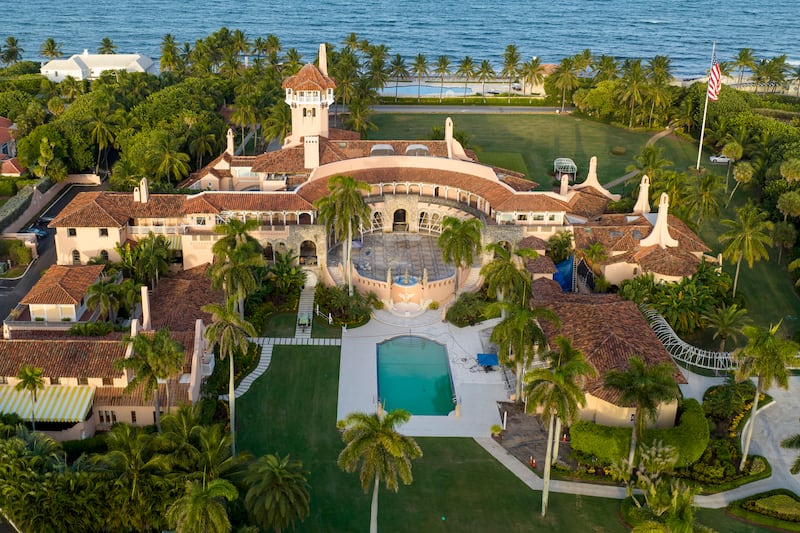After a lifetime in sales and television Donald Trump, more than most, is fully aware of the importance of imagery.
This perhaps explains why the former president seemed very unhappy at a remarkable photograph appended to a court filing by the US department of justice last Tuesday.
US authorities are investigating how dozens of classified documents ended up being taken from the White House after Trump left office and moved to Mar-a-Lago, his residence and club at Palm Beach in Florida.
The department of justice contended it had been trying to get Trump to return this material but met partial co-operation at most.
Eventually, it took an unprecedented FBI raid the home of the former president last month to retrieve documents it believed remained there, even after it had been assured all classified material had been given back.
Trump and his allies have suggested that the former president is, effectively, the victim of political persecution.
Various stories have been put out to explain what some of the country’s most sensitive secret documents were doing in a high-end club open to the public for weddings, galas and private parties.
There were claims the documents were planted by the FBI, that Trump had declassified them all anyway, and that he was using them as research material for a book. In essence the message was there was nothing to justify federal officers raiding the home of a former president.
A Trump lawyer on Thursday told a court the whole issue was like a dispute over the late return of a library book.
Perhaps to give a clear indication to Trump supporters of what exactly was at play, in an appendix at the rear of its court filing on Tuesday, the department of justice included a photograph of a some of the material obtained from Trump’s “presidential office” in Mar-a-Lago. On the ground beside a box containing framed magazine covers were five yellow folders labelled “top secret” and a red one marked “secret”.
The image was a standard photograph of collected evidence, with a ruler set down beside the documents to show their actual size. The documents had been stored in containers or in desks. But to the immediate outside eye it looked as if they had just been found strewn across a carpet.

Perhaps recognising the danger of the implications, Trump, in one of many social media messages to supporters this week, criticised the photograph specifically: “Terrible the way the FBI, during the raid on Mar-a-Lago, threw documents haphazardly all over the floor. Perhaps pretending it was me that did it!”
US intelligence agencies are to carry out a damage assessment on the risk to national security if the documents found at Trump’s property had been disclosed.
There is no indication as yet that the department of justice will prosecute Trump over the classified documents. However, the search warrant for the raid listed three criminal laws as the basis of the investigation, including the espionage act.
Trump’s lawyers have sought to play down the importance of the classified documents being found at his residence, suggesting it should not be alarming that classified material was found among the records of a former president.
Trump has looked to have the courts appoint an independent assessor to go through the material taken from his residence. Critics argue that this is aimed at delaying the process.
Read more
Empty folders marked classified included in material seized at Trump’s home
Sean Spicer on Newstalk: An intriguing interview with Trump’s disarmingly gormless press guy
Former NYPD officer gets 10 years in longest Capitol attack sentence
Judgment reserved in Trump search case
Under US law the papers of a US president belong to the nation, not to the occupant of the White House.
In January the US national archives recovered 15 boxes of documents which had been taken to Mar-a-Lago after Trump left office. Concern was raised after it was discovered that these included 184 classified documents, with some marked as “top secret”. The department of justice issued a subpoena to obtain any further documents at Trump’s residence.
FBI and justice officials visited Mar-a-Lago in June and were given an envelope containing 38 documents with classification markings, including five marked “confidential”, 16 marked “secret” and 17 marked “top secret”.
The department of justice told a Florida court on Tuesday that it had suspicions that more remained despite assurances from Trump’s representatives that all relevant material had been handed over following a “diligent search”.
It said it had “developed evidence that Government records were likely concealed and removed from the storage room and that efforts were likely taken to obstruct the government’s investigation”.
It was this concern that led to the FBI raid on August 8th during which officers found classified documents in the storage room as well as in the former president’s office — including three classified documents found not in boxes, but in desks.
It said FBI, in a matter of hours, had recovered twice as many classified documents as had been found in the “diligent search” by Trump’s representatives in June.

The United States and its intelligence community takes the issue of confidential documents very seriously. Mishandling such sensitive information can see the individuals responsible going to jail.
The US has three levels of classification: confidential, secret and top secret. The highest of these is top secret, which is defined as material that “reasonably could be expected to cause exceptionally grave damage to the national security” if it got out. Within this classification level there is also sensitive compartmented information which essentially is only provided to individuals — even those with top secret clearance — if they have a need to know about it.
Classified material is held close to the chest not just to protect the lives of spies and agents who generate it. The United States also knows that if adversaries such as Russia or China or Iran found out that Washington was learning their secrets they would take immediate efforts to block the method by which he information was obtained. It would be unlikely that similar information would be obtainable in the future.
In some cases classified documents can only be read by those with the appropriate clearances in specially-protected rooms or buildings known as a sensitive compartmented information facility.
It is not known precisely what was in the classified material found in Mar-a-Lago.
However, the photograph in the court filing allowed the media and interested individuals to enhance the image and uncover some hints.
Many of the documents in the photograph are cover sheets placed on top of material to set out its classification and the level of access needed to read it.
Five are marked as “top secret” and another at the bottom of the photo is labelled “secret/SCI”. This “secret” document has written beneath “UP TO HCS-P/SI/TK”
In the intelligence world HCS-P refers to material generated by human sources — spies or informants; SI indicates it came from telephone or other communication surveillance while TK relates to images taken from spy satellites.
In some documents dates can be determined. One appears to be dated Wednesday, May 9th, 2018. Bloomberg News and the Washington Post reported this was the day after Trump announced the US would be pulling out of the Iran nuclear agreement.
Even before the controversy over classified documents on its premises, for some Mar-a-Lago, which Trump visited frequently, had been of concern almost since his election as president. In 2017 the US political publication Politico described it as a heaven for spies.
The public cannot access the official retreat of presidents at Camp David or their private homes.
However, Mar-a -Lago is different. It markets itself as the epicentre of the social scene in Palm Beach. It has members who pay a reported $200,000 joining fee and a $14,000 annual subscription. It is also open for weddings and other events.
In February 2017, Trump was hosting the then Japanese prime minister Shinzo Abe at a dinner at his club when word came through about a North Korean missile launch. While club members and guests watched, the president and his advisers huddled to draw up a response.
In 2019 a 32-year-old Chinese woman was arrested on the property. She was carrying five cell phone SIM cards, a hard drive, nine USB thumb drives including one primed with malware, and a device that could detect electronic signals. She had two Chinese passports, and investigators found a device for detecting hidden cameras when they searched her hotel room. She was deported after serving eight months in prison. However mystery surrounds what she was doing at Mar-a-Lago.
As the country prepares for crucial elections in November which republicans want to see dominated by the economy, the controversy over the classified documents at Mar-a-Lago means Donald Trump continues to be centre stage on the American political landscape.



















